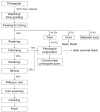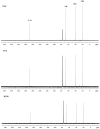Valorisation of Pineapple Cannery Waste as a Cost Effective Carbon Source for Poly 3-hydroxyabutyrate (P3HB) Production
- PMID: 37571191
- PMCID: PMC10422540
- DOI: 10.3390/polym15153297
Valorisation of Pineapple Cannery Waste as a Cost Effective Carbon Source for Poly 3-hydroxyabutyrate (P3HB) Production
Abstract
Pineapple is one of the most important agro-industrial sugar-based fruits in Thailand. In this study, the waste stream from pineapple cannery processing was utilised and evaluated for potential use in the production of a main biopolymer group widely known as polyhydroxyalkanoates (PHAs) through aerobic batch fermentation. Firstly, pineapple cannery waste (PCW) collected from three processing sources, pineapple juice (PAJ), peel and core juice (PCJ), and pulp-washing water (PWW), was used as a carbon source. Secondly, it was characterised and pretreated. Then, batch fermentation was performed by using the optimal condition (200 rpm agitation rate, 37 °C, and fermentation time of 72 h) under two different nutrient conditions in each type of carbon source. The results revealed that PHAs were produced during 24-72 h of fermentation without any interference. The PHAs product obtained was characterised by their properties. Interestingly, GC-MS showed homopolymer of poly 3-hydroxybutyrate (P3HB) group characteristics, such as OH, CH, and C=O; meanwhile, H1 NMR analysis showed signals corresponding to CH3, CH2, and CH, respectively. Remarkably, utilising the PCW showed a high-potential cheap carbon source for the production of PHAs as well as for the treatment of wastewater from the fruit industry.
Keywords: fermentation; pineapple processing waste; polyhydroxyalkanoates (PHAs); polymer.
Conflict of interest statement
The authors declare no conflict of interest.
Figures




Similar articles
-
Characterization of a polyhydroxyalkanoate obtained from pineapple peel waste using Ralsthonia eutropha.J Biotechnol. 2016 Aug 10;231:232-238. doi: 10.1016/j.jbiotec.2016.06.018. Epub 2016 Jun 15. J Biotechnol. 2016. PMID: 27316828
-
Cost-effective defined medium for the production of polyhydroxyalkanoates using agricultural raw materials.Bioresour Technol. 2015 Oct;194:67-74. doi: 10.1016/j.biortech.2015.06.087. Epub 2015 Jul 2. Bioresour Technol. 2015. PMID: 26185927
-
[Formation of polyhydroxyalkanoates during the dual-nutrient-limited zone by Ralstonia eutropha].Sheng Wu Gong Cheng Xue Bao. 2003 Jul;19(4):497-501. Sheng Wu Gong Cheng Xue Bao. 2003. PMID: 15969073 Chinese.
-
Microbial biotechnology approaches for conversion of pineapple waste in to emerging source of healthy food for sustainable environment.Int J Food Microbiol. 2022 Jul 16;373:109714. doi: 10.1016/j.ijfoodmicro.2022.109714. Epub 2022 May 7. Int J Food Microbiol. 2022. PMID: 35567891 Review.
-
P3HB from CH4 using methanotrophs: aspects of bioreactor, fermentation process and modelling for cost-effective biopolymer production.Front Bioeng Biotechnol. 2023 Jun 19;11:1137749. doi: 10.3389/fbioe.2023.1137749. eCollection 2023. Front Bioeng Biotechnol. 2023. PMID: 37404685 Free PMC article. Review.
References
-
- Du C., Sabirova J., Soetaert W., Lin S.K.C. Polyhydroxyalkanoates production from low-cost sustainable raw materials. Curr. Chem. Biotechnol. 2012;6:14–25.
LinkOut - more resources
Full Text Sources
Molecular Biology Databases
Miscellaneous

